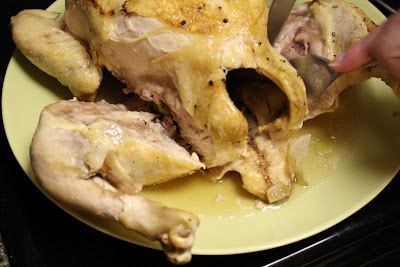So we picked up 4 big portobellos at Trader Joes and I washed and trimmed the stems (we saved the stems for the filling later on).
 |
| From Kitchen Assays |
Greg then prepared the marinade (adapted from the recipe, but we only made 2/3 of what they called for):
2/3 cup olive oil
1/3 cup balsamic vinegar
1/3 cup reduced-sodium soy sauce
1 garlic cloves, pressed
Dash of coarse kosher salt
Dash of freshly ground black pepper
A little less than 1/4 cup Port (instead of Marsala) (optional)
~A bunch fresh thyme sprigs
4 large portobello mushrooms
We combined these ingredients in a dish and stuck the mushrooms in the fridge to marinate for approximately 3 hrs.
 |
| From Kitchen Assays |
Close to the end of the marination time we prepared the fillings using my handy little mini food processor (first time used yay!).
1 10-ounce package frozen spinach
12 oz button mushrooms
1ish tablespoons olive oil
2/3 cup chopped sweet onion (such as Maui or Vidalia)
2 garlic cloves, pressed
~1/4 cup finely grated Parmesan cheese
~1/4 cup unseasoned dry breadcrumbs
3.5 oz soft fresh goat cheese, crumbled
We chopped all the mushrooms (plus the saved portobello stems) in the processor, and cooked the frozen spinach in the microwave (following the ingredients on the package). We heated up some oil in our pan and sauteed the onions first. After the onions browned a bit we stirred in the garlic and then added the chopped mushrooms. The mushrooms and onions were cooked for about 8 minutes and then transferred to a dish to cool to room temperature.
 |
| From Kitchen Assays Chop chop! |
Meanwhile, we preheated the oven to 400 degrees and put the marinated mushrooms gill side down on a baking sheet, and let the mushrooms roast for 15 minutes. (Note: I recommend laying down some foil because it made a mess on our pans!) Once the filling mixture was cooled we tossed with the remaining ingredients and set aside. We then turned the mushrooms over and filled with the stuffing. We felt there was a lot more filling than there was room in the mushrooms, but we made mountains of filling anyways. We sprinkled the mounds of filling with more parmesan cheese and baked for about 15 more minutes. Good stuff!
 |
| From Kitchen Assays |
 |
| From Kitchen Assays |



















